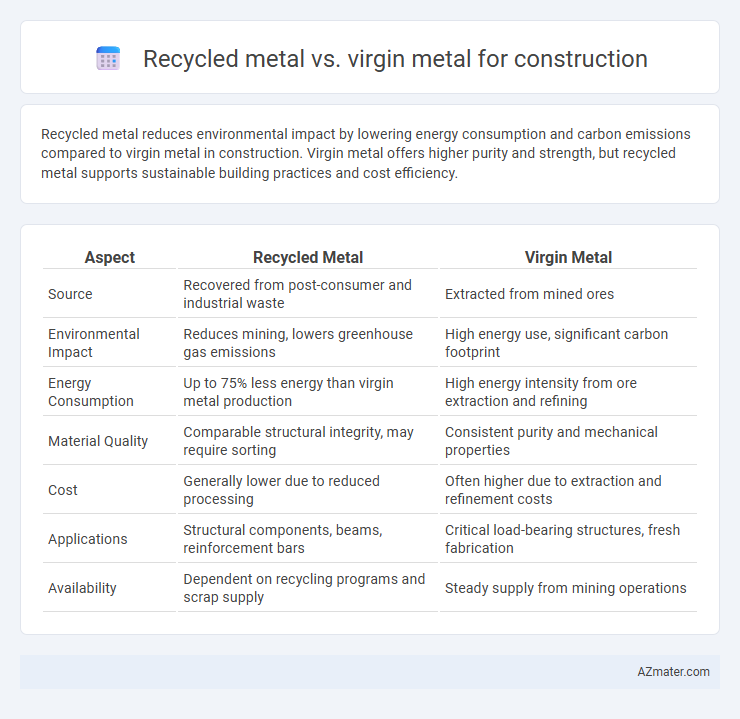Recycled metal reduces environmental impact by lowering energy consumption and carbon emissions compared to virgin metal in construction. Virgin metal offers higher purity and strength, but recycled metal supports sustainable building practices and cost efficiency.
Table of Comparison
| Aspect | Recycled Metal | Virgin Metal |
|---|---|---|
| Source | Recovered from post-consumer and industrial waste | Extracted from mined ores |
| Environmental Impact | Reduces mining, lowers greenhouse gas emissions | High energy use, significant carbon footprint |
| Energy Consumption | Up to 75% less energy than virgin metal production | High energy intensity from ore extraction and refining |
| Material Quality | Comparable structural integrity, may require sorting | Consistent purity and mechanical properties |
| Cost | Generally lower due to reduced processing | Often higher due to extraction and refinement costs |
| Applications | Structural components, beams, reinforcement bars | Critical load-bearing structures, fresh fabrication |
| Availability | Dependent on recycling programs and scrap supply | Steady supply from mining operations |
Introduction to Metal Usage in Construction
Recycled metal in construction significantly reduces environmental impact by lowering energy consumption and minimizing raw material extraction compared to virgin metal. Virgin metal offers consistent mechanical properties but involves higher carbon emissions due to mining and processing. Utilizing recycled metal not only supports sustainable building practices but also meets industry standards for strength and durability in structural applications.
Overview of Recycled Metal
Recycled metal in construction offers significant environmental benefits by reducing the need for virgin metal extraction, which lowers energy consumption and greenhouse gas emissions by up to 95%. It retains the same structural strength and durability as virgin metal, making it a cost-effective and sustainable choice for building projects. The use of recycled metals also supports circular economy principles by minimizing waste and conserving natural resources.
Overview of Virgin Metal
Virgin metal, extracted directly from natural ore deposits, offers high purity and consistent mechanical properties crucial for structural integrity in construction projects. Its production involves energy-intensive mining and smelting processes, often resulting in higher carbon emissions compared to recycled metal. Despite environmental concerns, virgin metal remains essential for applications requiring specific grades and strength standards that recycled metals may not always meet.
Environmental Impact Comparison
Recycled metal reduces greenhouse gas emissions by up to 58% compared to virgin metal, significantly lowering the environmental footprint of construction projects. It requires 75% less energy during production, conserving natural resources and reducing mining waste. Utilizing recycled metals also minimizes landfill use and pollution, contributing to sustainable building practices.
Energy Consumption: Recycled vs. Virgin Metal
Recycled metal in construction consumes up to 95% less energy compared to virgin metal extraction and processing, significantly reducing the carbon footprint. Mining, refining, and smelting virgin metals require intensive energy inputs, contributing to higher greenhouse gas emissions. Utilizing recycled metals not only conserves natural resources but also promotes sustainable energy practices in the construction industry.
Cost Analysis and Economic Benefits
Recycled metal offers significant cost savings compared to virgin metal due to lower raw material and energy expenses, reducing overall construction costs. The use of recycled metals promotes economic benefits by decreasing demand for mining, minimizing environmental compliance costs, and enhancing resource efficiency. Construction projects integrating recycled metal experience improved budget sustainability and contribute to circular economy practices.
Structural Performance and Quality Differences
Recycled metal often matches virgin metal in structural performance due to advanced refining processes that remove impurities and restore material integrity. While virgin metal typically offers consistent chemical composition and predictable mechanical properties, high-quality recycled metal can achieve comparable strength, ductility, and durability when properly processed and tested. The primary quality differences arise from trace contaminants in recycled metal, but modern certification standards ensure structural reliability suitable for demanding construction applications.
Availability and Supply Chain Considerations
Recycled metal offers enhanced availability due to the continuous influx of scrap materials from demolition and manufacturing waste, reducing dependency on finite virgin ore deposits. The supply chain for recycled metal is generally shorter and more energy-efficient, as it bypasses the extensive mining and refining processes required for virgin metal, ensuring faster turnaround times and lower logistical costs. However, fluctuations in scrap supply and quality can affect the consistency of recycled metal availability, whereas virgin metal supply chains are more stable but subject to geopolitical and environmental constraints.
Regulatory Standards and Certifications
Recycled metal used in construction must meet stringent regulatory standards such as ASTM International specifications and ISO 9001 certification to ensure quality and safety comparable to virgin metal. Certifications like LEED and Cradle to Cradle emphasize the environmental benefits and compliance of recycled metal, promoting sustainable building practices. Virgin metal, while often subject to rigorous material testing under standards like EN 10025 or AISC, lacks the same circular economy advantages but ensures consistent mechanical properties for critical structural applications.
Future Trends in Metal Sourcing for Construction
Recycled metal is increasingly favored in construction due to its lower environmental impact and cost-effectiveness compared to virgin metal, which requires intensive mining and energy consumption. Future trends indicate a growing reliance on circular economy principles, emphasizing closed-loop recycling systems that enhance metal reuse without compromising structural integrity. Advances in material science and digital tracking technologies are expected to optimize recycling processes, ensuring sustainable and traceable metal sourcing aligned with global carbon reduction targets.

Infographic: Recycled metal vs Virgin metal for Construction
 azmater.com
azmater.com